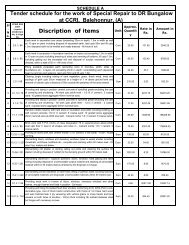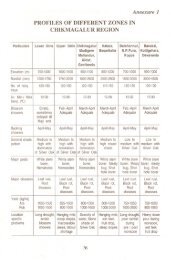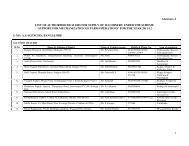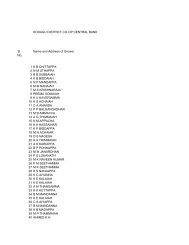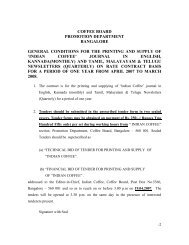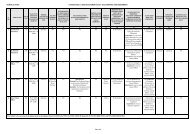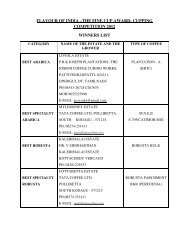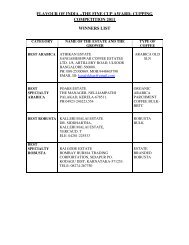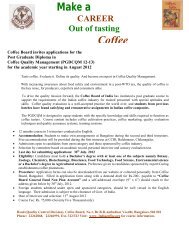COFFEE CULTIVATION GUIDE - Coffee Board of India
COFFEE CULTIVATION GUIDE - Coffee Board of India
COFFEE CULTIVATION GUIDE - Coffee Board of India
You also want an ePaper? Increase the reach of your titles
YUMPU automatically turns print PDFs into web optimized ePapers that Google loves.
48<br />
useful tool. The status <strong>of</strong> nitrogen, phosphorus, potassium, calcium, magnesium,<br />
sulphur and other micro-nutrients can be exactly determined by chemical analysis <strong>of</strong><br />
the leaves and deficiency <strong>of</strong> any <strong>of</strong> the essential nutrient element can be identified to<br />
take appropriate step in time before it becomes a limiting factor in productivity <strong>of</strong> the<br />
plant. Simultaneous analysis <strong>of</strong> soil and complimentary leaf samples gives precise<br />
requirement <strong>of</strong> nutrients and helps in enhancing the accuracy <strong>of</strong> fertilizer<br />
recommendation services since these analyses are complimentary to each other.<br />
The leaf analysis can be done ideally during February-March and September-<br />
November months. Third pair <strong>of</strong> leaves from growing tip <strong>of</strong> Robusta plant branches<br />
from the 2/3 height <strong>of</strong> the over all plant has to be collected randomly from the field. A<br />
minimum <strong>of</strong> 25 pairs <strong>of</strong> leaves from one hectare land is necessary for precise analysis.<br />
The leaf samples should be collected only during the morning time preferably before<br />
10.00 a.m and placed between two sheets <strong>of</strong> blotting paper and packed in a perforated<br />
polythene bags and sent to the laboratory immediately. The details on the block<br />
history, age <strong>of</strong> the plant, fertilizers applied and crop harvested should be sent to the<br />
laboratory while sending the leaf samples. These samples are then washed with clean<br />
water and dilute hydrochloric acid to remove any superficial chemicals, dust and<br />
spray particles adhering to the leaf surfaces before processing for chemical analysis.<br />
6. CBB management<br />
All the left over berries on the plants have to be cleanly collected and install<br />
broca traps in the field. Follow other recommended phyto-sanitary control measures.<br />
<strong>COFFEE</strong> BERRY BORER BORING THE <strong>COFFEE</strong> BERRY<br />
7. Pruning<br />
Pruning is an important cultural operation in c<strong>of</strong>fee estates. Pruning <strong>of</strong> plants<br />
reduces the greater risk <strong>of</strong> biennial bearing habits <strong>of</strong> the plants and helps in harvesting<br />
average crop each year. Pruning helps in reducing the exhaustion in plants and<br />
increases the fertilizer use efficiency by the plants. Other advantages <strong>of</strong> pruning are<br />
that all the plant parts get good aeration and light and helps in reducing the pest and<br />
disease incidence level.<br />
In Robusta plantations, pruning is done immediately after the harvest. But is<br />
strongly suggested that pruning operation should be started after observing the<br />
environmental situations like there should be sufficient soil moisture and weather<br />
48



